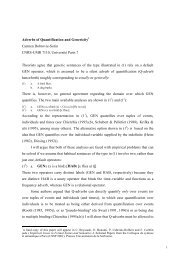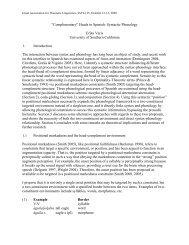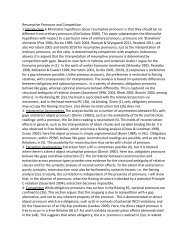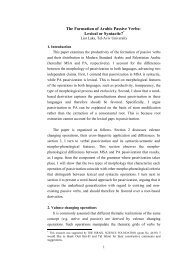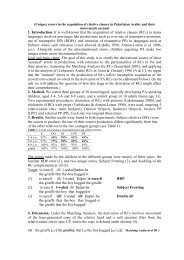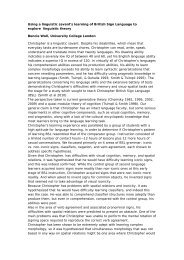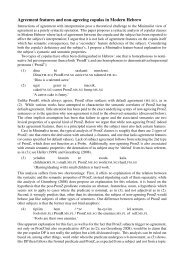paper
paper
paper
Create successful ePaper yourself
Turn your PDF publications into a flip-book with our unique Google optimized e-Paper software.
The pronoun in (36) should be considered locally, but it is not at the ARG–ST level of the<br />
sentence head. It appears deeper in the NP structure and for this reason the recursion (with<br />
the stop condition added) is necessary.<br />
The definition of local and global o-binding and o-free relations do not need reformulation;<br />
for ease of presentation, we will rename them: (local) s-binding and (locally) s-free.<br />
(37) Y (locally) s-binds Z just in case Y and Z are coindexed and Y (locally)<br />
s-commands Z. If Z is not (locally) s-bound, the it is said to be (locally) s-free.<br />
Following the proposal for Polish, I can now formulate the binding theory for Russian.<br />
(38) BINDING THEORY FOR RUSSIAN 7 :<br />
Principle A. A reflexive anaphor must be s-bound.<br />
Principle B. A pronoun must be locally s-free.<br />
Principle C. A non-pronoun must be s-free.<br />
Now consider (31) again. This is a simple sentence with a possessive expression. svoju<br />
(’self’s’) is a possessive anaphor and should be s-bound according to principle A. Tanya is<br />
the s-binder of svoju in case they are coindexed and Tanya s-commands the phrase svoju<br />
mašinu because Tanya is the subject and the phrase svoju mašinu is a complement, (i.e.<br />
belongs to the ARG–ST) of the same lexical head, prodala. According to clause (iii) of<br />
the definition of (34), if Tanya s-commands the whole phrase, it s-commands its head, in<br />
this case mašinu. Svoju is an adjunct of mašinu and therefore belongs to the ARG–ST of<br />
mašinu. Applying clause (ii) of (34) I prove that Tanya s-commands svoju.<br />
5 Formal Analysis of S-coordination of NPs<br />
As evident from the data discussed so far, the s- and ordinary coordinate constructions<br />
should be treated separately in Russian. In addition, as has been pointed out in the first<br />
section, only non-pronominal NP’s can participate in s-coordination:<br />
(39) (a) On<br />
He<br />
s<br />
with<br />
sestroi<br />
sister<br />
kupil<br />
bought.SG.Masc.3P<br />
He bought a computer with his sister.<br />
komputer.<br />
computer<br />
7 The principles of the binding theory are not applied if VAL—SUBJ is not a noun phrase for the head of<br />
the phrase



